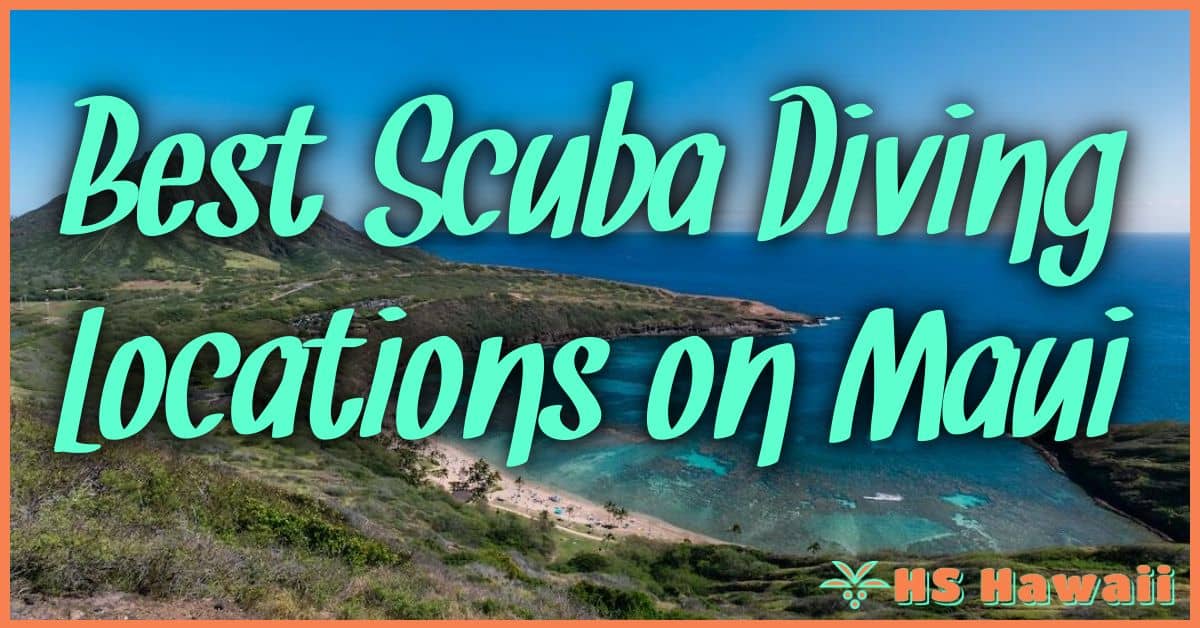Planning a solo wellness trip to Hawaii is a great way to focus on my well-being while exploring beautiful islands. Whether I want to relax on pristine beaches or hike lush trails, traveling alone lets me move at my own pace and choose what makes me happiest.

I can also join yoga retreats and try new activities that recharge me. Solo travel in Hawaii helps me enjoy the islands safely and confidently.
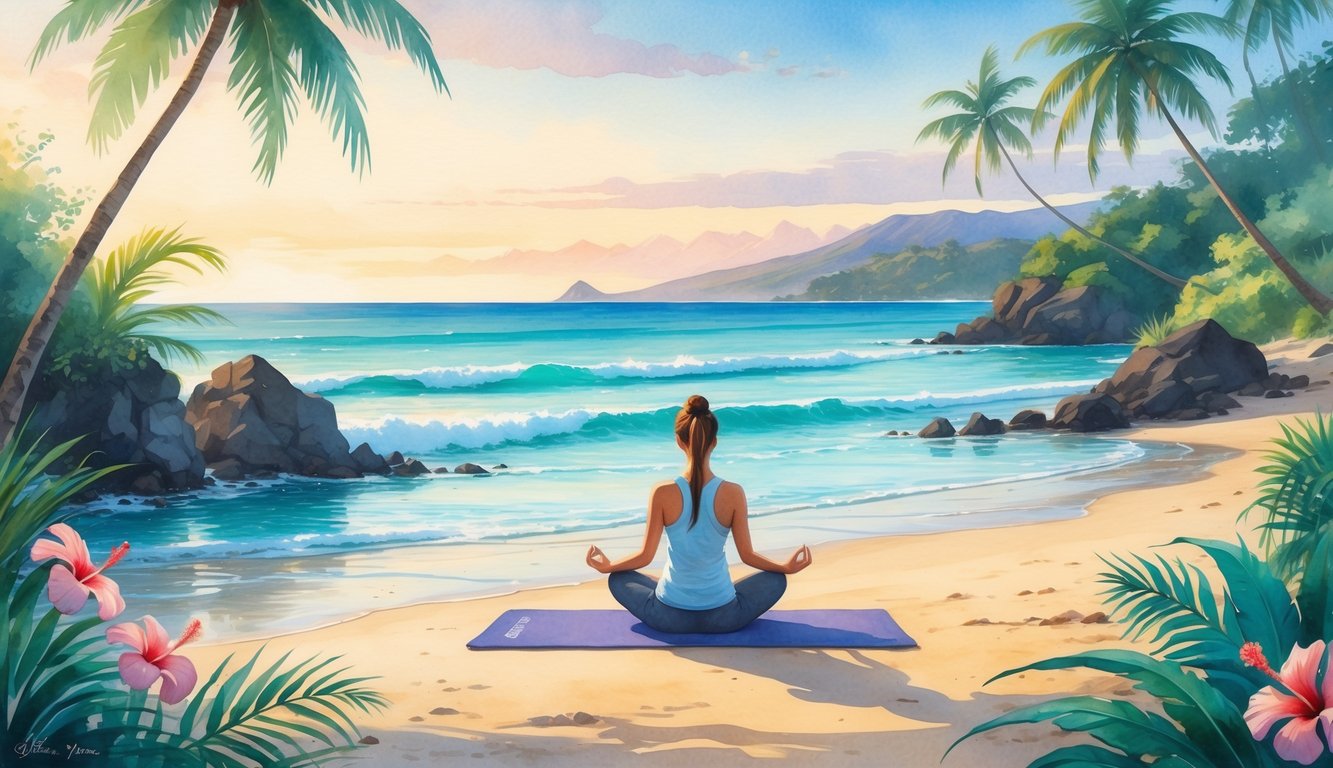
I don’t need a group to experience the best of Hawaii. I pick activities that match my goals, like spa treatments, healthy local food, or outdoor adventures.
By staying mindful and prepared, I make the most of my trip and stay safe, as many experts recommend for solo travel in Hawaii.
With so many options for relaxation and exploration, planning a solo trip to Hawaii feels exciting and rewarding.
I look forward to the warm weather, friendly locals, and endless chances for self-care and growth.
Why Choose Hawaii for a Solo Wellness Trip

Hawaii offers a warm climate, welcoming people, and peaceful scenery. As a solo traveler, I enjoy a unique mix of cultural experiences and deep relaxation.
The Aloha Spirit and Hawaiian Culture
When I arrive, the Aloha Spirit makes me feel welcome. People in Hawaii show kindness to everyone—even strangers.
This sense of care and respect shapes Hawaiian culture. Learning about local traditions helps me connect to the island.
I watch hula dancing, listen to native music, and try local foods. I join a lei-making class and meet other solo travelers.
Being part of these activities teaches me the meaning behind Aloha. Aloha means love, peace, and living with a sense of community.
This encourages me to slow down and appreciate the little things.
Benefits of Solo Travel to Hawaii
Traveling alone in Hawaii lets me set my own pace. I can hike a trail at sunrise, relax on the beach, or try a new wellness activity whenever I want.
The islands feel safe for solo travelers. I explore places like Waikiki Beach, the Road to Hana, and small local cafés.
Many group tours and workshops offer chances to meet other solo visitors. I choose places and activities that fit my needs and spending limit, with options from hostels to boutique hotels.
The average solo trip costs about two thousand five hundred to five thousand dollars per week, depending on travel style.
Fostering Relaxation and Mindfulness
Hawaii’s gentle breezes, clear water, and green mountains create a peaceful setting. I book a massage at a spa on Waikiki Beach, where ocean sounds help me relax.
Many visitors come for yoga retreats, guided meditations, or beach walks at sunset. These activities help me focus on my mental well-being and self-care.
I find quiet places to reflect, often meditating by the ocean or under tropical trees. The natural beauty makes it easy to stay present and mindful during my solo wellness trip.
Best Time to Visit for a Wellness Experience
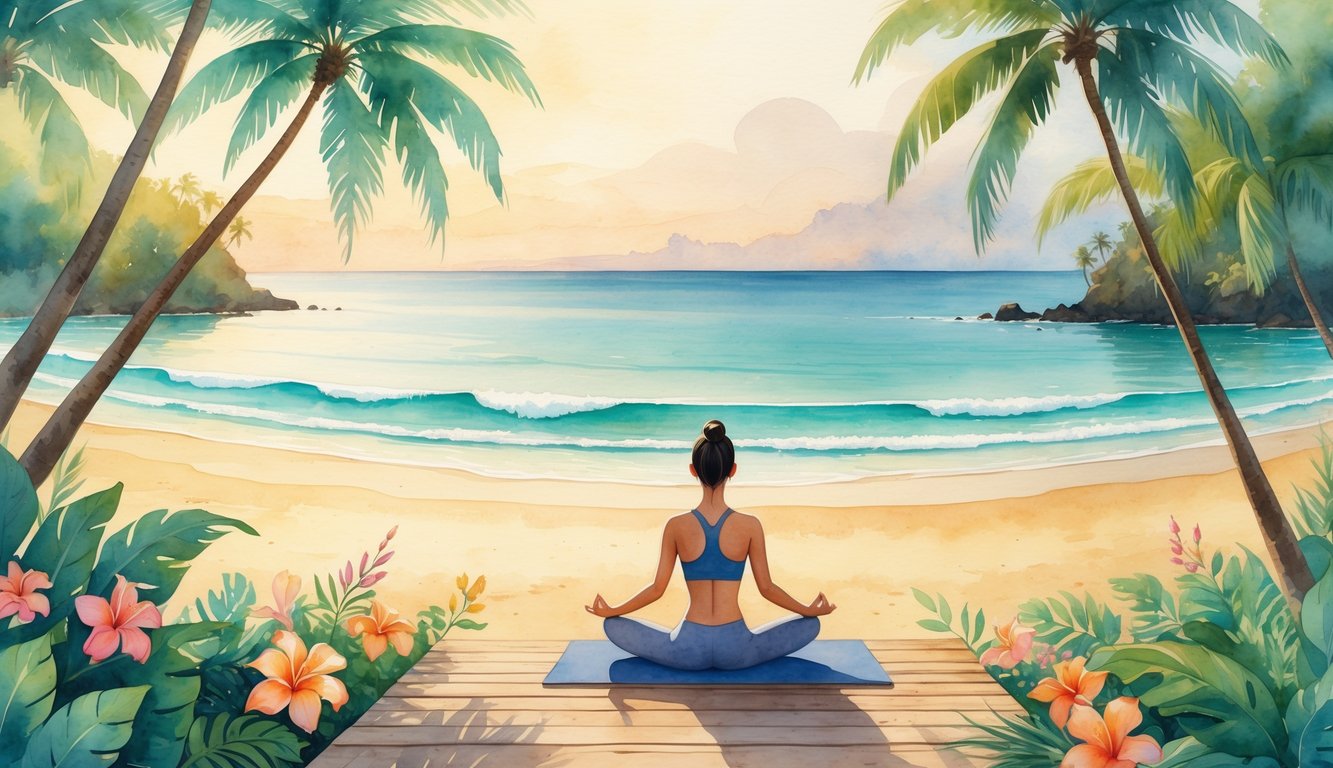
Choosing when to visit Hawaii affects how crowded the beaches are and how peaceful my retreat feels. The right mix of good weather and special events helps me relax and recharge.
Understanding Hawaiian Weather
Hawaii has a warm, tropical climate all year, which is perfect for outdoor wellness activities. There are two main seasons: summer (May to October) and winter (November to April).
I find May and September especially pleasant. The weather is sunny but not too hot, and there are fewer tourists.
The ocean is calm, making it great for swimming or stand-up paddleboard yoga. Rain is more common in winter, especially on the north and east sides of the islands.
The rain usually doesn’t last long, but it can affect outdoor plans. I stick to the leeward (west and south) sides of Oahu, Maui, or the Big Island for less rain.
Here’s a quick table showing average high temperatures and rainfall:
| Month | Oahu High (°F) | Maui High (°F) | Rainfall (inches) |
|---|---|---|---|
| January | 80 | 81 | 3-4 |
| March | 81 | 82 | 2-3 |
| July | 87 | 88 | <1 |
| September | 87 | 88 | <1 |
Seasonal Events and Festivals
My wellness retreat feels more special when I join local Hawaiian events. April and May feature cultural festivals, like the Merrie Monarch Festival—Hilo’s famous hula celebration.
If I want a quieter trip, I avoid December through early January when holiday travelers visit Hawaii. In summer, I join sunrise yoga classes on the beach or food festivals with fresh, local produce.
September and October are less crowded and often have wellness workshops, like guided forest bathing or plant-based cooking classes. These months let me experience authentic Hawaii without big crowds or high prices.
For more tips on solo wellness travel, I check guides that cover wellness retreats and activities.
Selecting the Right Hawaiian Island
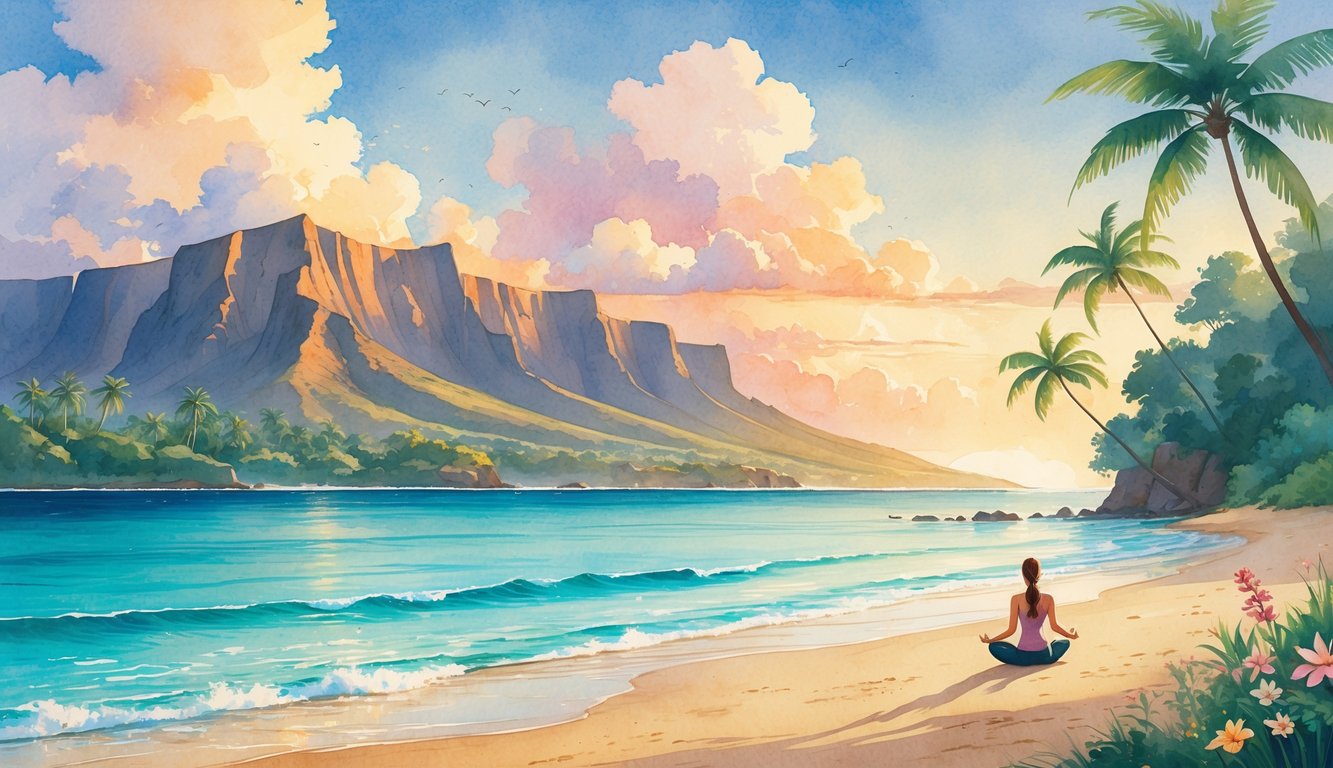
Each Hawaiian island offers something unique for a solo wellness trip. Some islands are better for adventure and hiking, while others focus on relaxation and wellness retreats.
Oahu: Culture, Beaches, and Wellness Retreats
When I want a mix of city life, beaches, and wellness options, I choose Oahu. Honolulu is the heart of Oahu and has yoga studios, spas, and healthy cafes.
Waikiki Beach offers sunrise yoga, surf lessons, and paddleboarding. Oahu has several wellness retreats where I can enjoy guided meditation and healthy meals.
I visit local farmers’ markets for fresh tropical fruits. The North Shore is quieter and is a peaceful spot for relaxing walks.
I also enjoy the rich Hawaiian culture at historic sites like Iolani Palace and the Bishop Museum. This lets me balance adventure with rest and healthy routines.
For more tips, check out this guide to solo trips in Hawaii.
Maui: Scenic Drives and Outdoor Adventure
Maui is the best island for solo travel if I want outdoor adventures and stunning scenery. I drive the famous Road to Hana and see waterfalls, bamboo forests, and black sand beaches.
I stop at roadside stands for fresh coconut water and banana bread. Wellness is easy to find in Maui, with beachfront massages and yoga on the sand.
I hike in Haleakalā National Park to see sunrise from above the clouds. Maui balances adventure, relaxation, and healthy living, making it great for solo travelers.
Kauai: The Garden Isle’s Natural Beauty
Kauai, called the Garden Isle, delights me with green valleys, tall cliffs, and quiet beaches. This island feels peaceful and gives me space for self-reflection.
There are many hiking trails through rainforests and along the Napali Coast. I meditate near waterfalls or book a healing lomilomi massage in a small spa.
Because the island is smaller and less crowded, I focus on personal health without distractions. Kauai is a good choice if I want to journal, do gentle yoga, or just sit on the beach and listen to the ocean.
Big Island: Volcanoes and Tranquility
I choose the Big Island when I want wide-open spaces and unique natural beauty. This island is much bigger than the others, so I have plenty of room to explore solo.
I visit Hawaii Volcanoes National Park to see active volcanoes and walk through lava tubes. For relaxation, I book a mineral soak at a spa or meditate on a black sand beach.
The Big Island has many climates and landscapes, from rainforests to rocky coasts. I find it easy to build my own wellness routine here, without crowds or noise.
For more information, read this travel guide for solo travelers in Hawaii.
Planning Your Solo Trip to Hawaii
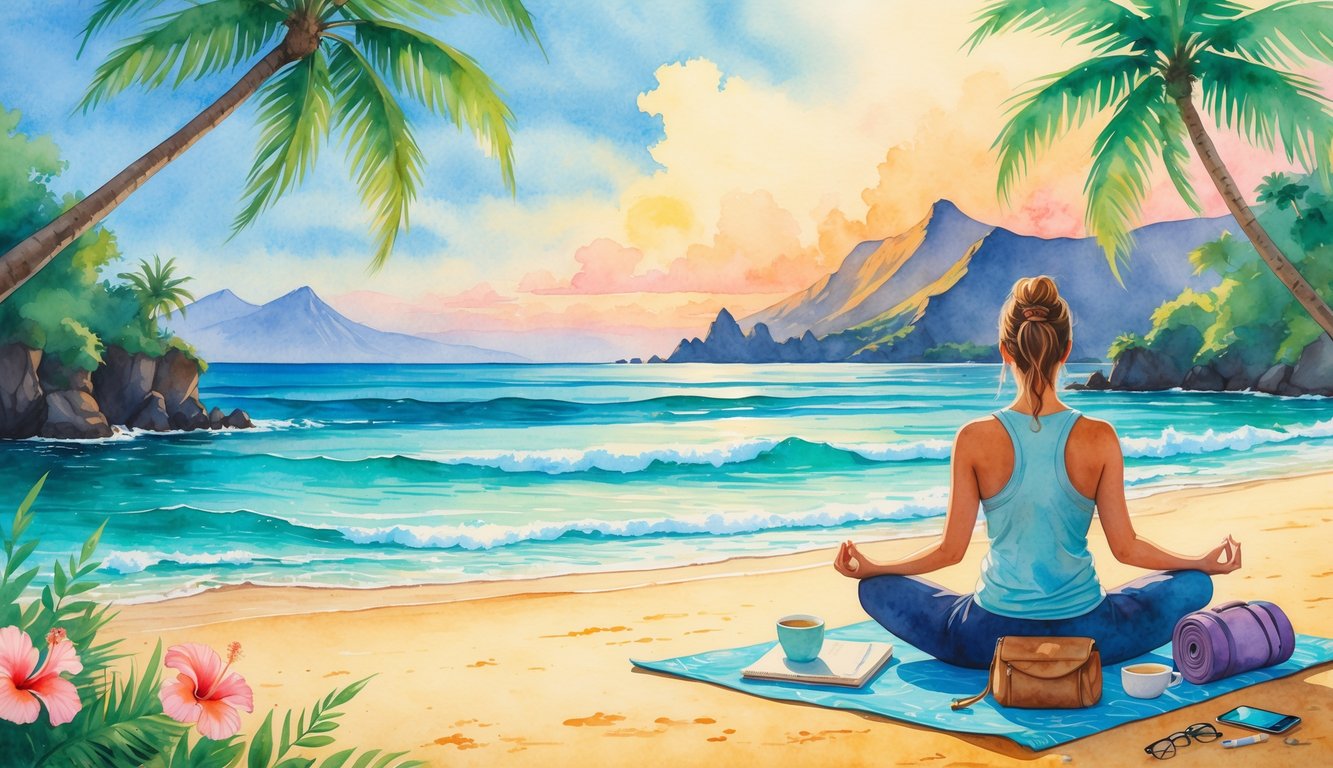
When I plan my solo trip to Hawaii, I make choices that support my wellness goals. Good planning helps me feel safe, stay on budget, and create a peaceful experience.
Crafting an Itinerary for Wellness
I look for wellness-focused activities that help me recharge and relax. In Hawaii, I book yoga sessions on the beach, visit healing spas, and hike quiet nature trails.
I make a list of things I want to do, such as morning swims or meditation workshops, and add them to a simple daily schedule.
Using a table helps me keep track:
| Day | Morning | Afternoon | Evening |
|---|---|---|---|
| Monday | Yoga by ocean | Spa massage | Guided meditation |
| Tuesday | Nature hike | Healthy lunch | Sunset swim |
I also set aside time for unplanned moments. This way, I can rest or explore at my own pace.
Securing Travel Insurance
I always buy travel insurance for Hawaii before I go. It covers trip cancellations, lost luggage, and medical emergencies—especially important when I travel solo.
I check the policy to make sure it includes health coverage and activities like hiking or snorkeling.
Some key benefits I look for:
- Medical coverage
- Trip cancellation/interruption
- Lost or stolen belongings
- Protection for natural disasters
Knowing I’m covered helps me relax, even if something unexpected happens.
Budgeting and Costs
Traveling to Hawaii solo can be expensive, so I make a careful budget before my trip. I compare prices for flights, hotels, and activities.
A one-week solo trip can cost between about $2,500 and $5,000 depending on where I stay and what I do.
To save money, I look for:
- Direct flights with the best deals
- Affordable accommodation, like hostels or shared rentals
- Free or low-cost activities such as hikes or beach days
I also set money aside for meals and wellness treatments.
Sticking to my budget lets me enjoy my solo travel in Hawaii without worrying about running out of funds.
Accommodation Options for Solo Travelers

Choosing the right place to stay in Hawaii can set the tone for a wellness trip. I look for peace, comfort, and chances to connect with nature or like-minded people.
Wellness Resorts and Retreats
When I focus on self-care, I stay at a wellness resort or retreat. Many resorts in Hawaii offer daily yoga classes, guided meditation, spa treatments, and healthy meal options.
These resorts often sit near the ocean or in lush rainforests. Four Seasons Resort Hualalai has wellness programs and ocean-view spa huts.
The Fairmont Orchid is known for its Hawaiian healing traditions. Wellness retreats in Maui or the Big Island might provide group workshops and cooking classes.
Staff at these places train in wellness therapies. This creates a relaxing environment perfect for recharging on a solo trip.
I like meeting fellow travelers in classes or workshops, but I also get privacy when I need it.
Eco-Friendly Boutique Hotels
If I want to make my trip more sustainable, I search for eco-friendly boutique hotels. Many smaller hotels in Hawaii use solar power, offer biodegradable toiletries, and source their food from local farms.
Hawaii has boutique hotels such as The Surfjack Hotel in Honolulu and the Volcano Rainforest Retreat near Hawaii Volcanoes National Park. These places are committed to the environment and have unique, artistic décor.
Many have community spaces like gardens, rooftop terraces, or cozy lounges where I can unwind or chat with other guests.
Booking an eco-friendly hotel supports local businesses and reduces my carbon footprint. Often, these hotels offer tips on how to explore Hawaii responsibly.
Budget-Friendly Hostels and Guesthouses
For a solo traveler on a budget, hostels and guesthouses are a practical choice. I often find hostels near popular beaches or hiking trails on Oahu, Maui, and the Big Island.
They offer a bed in a dorm room or, for a bit more, a private room. Many hostels have common kitchens and lounge spaces, making it simple to meet other travelers.
Guesthouses in Hawaii feel homier compared to big hotels. Owners often give great advice on local spots and wellness activities.
Staying in a hostel or guesthouse is usually much cheaper than a resort. According to one cost breakdown for solo trips to Hawaii, a hostel bed might cost as little as $45 per night.
This means I can spend more on wellness classes, meals, or exploring the islands.
Getting Around the Hawaiian Islands
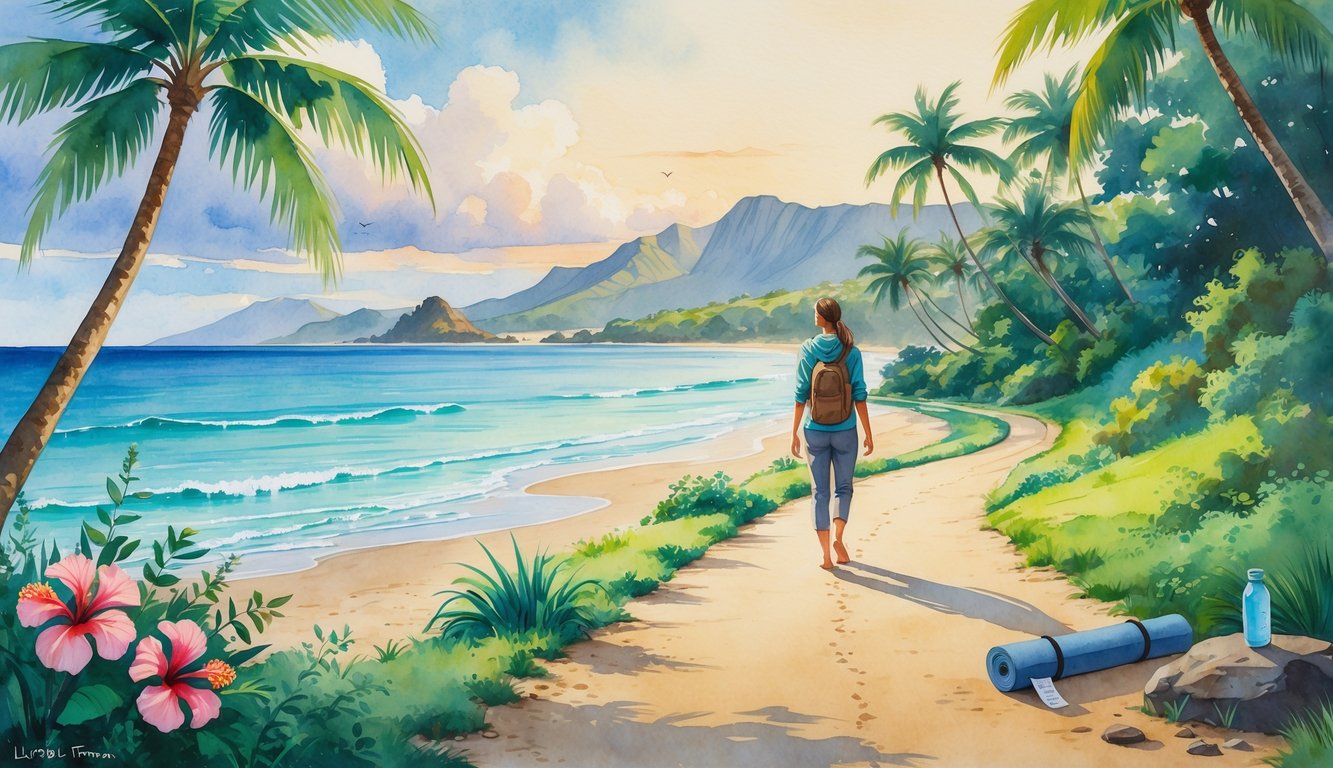
Planning how I’ll get around is just as important as choosing where to stay. The islands offer several ways to travel, and each option has its own pros and cons.
Inter-Island Transportation Options
If I want to visit more than one island, I fly between them. Major local airlines like Hawaiian Airlines and Southwest run short, frequent flights between islands like Oahu, Maui, Kauai, and the Big Island.
Most flights last under an hour. Booking in advance saves money, especially during busy seasons.
There are no bridges or car ferries between the main islands, so I leave extra time for airport security and baggage claims. Some companies offer ferries between Maui and Lanai or Molokai, but choices are limited.
When I schedule activities, I factor in travel time between airports and my lodging. Luggage limits and fees vary by airline.
Public Transit and Ride-Sharing
On Oahu, I use the public bus system, called TheBus, for getting around Honolulu, Waikiki, and other spots. Bus routes cover most of the island, but they don’t always reach nature trails or remote beaches.
Other islands like Maui, Kauai, and the Big Island have buses, but routes and schedules are limited. If I want to visit less touristy places, I check schedules closely so I don’t miss a ride.
For more flexibility, I use ride-sharing apps like Uber and Lyft in major towns. They can cost more, but they work well after a long hike or when I don’t want to drive.
Car Rentals and Scenic Drives
Renting a car gives me the freedom to explore hidden beaches, scenic overlooks, and places like the famous Road to Hana on Maui. Rental companies operate at all major airports.
A car is almost essential on the Big Island, where attractions are spread out. Parking can be hard to find in tourist hotspots, and some places charge fees.
Gas is more expensive than on the mainland, so I budget for that. For scenic drives, I bring water, snacks, and a map, especially in remote spots with limited cell service.
Some rental agencies let me book smaller vehicles or hybrids to save on costs and fuel. I make sure my route is safe and check for road closures, especially during rainy months.
Wellness Activities to Recharge Mind and Body

Relaxing on a solo trip to Hawaii lets me focus on my well-being. When I travel alone, I pick activities that boost my mood and help my body recover from stress.
Yoga and Meditation Retreats
Yoga and meditation retreats in Hawaii are ideal for solo travel. These retreats often take place on peaceful beaches or in green valleys.
Some offer sunrise yoga so I can start the day with gentle stretches and breathing exercises as the sun rises over the ocean. Guided meditation sessions help me clear my mind and stay present.
Many retreats use small group settings, so I can enjoy peace while also connecting with others if I choose. Experienced instructors lead classes for all levels, including beginners.
Some retreats focus on mindfulness and self-care, combining yoga sessions with journaling, walking meditations, and sound healing.
Here’s a simple breakdown of what I often find at a Hawaiian yoga and meditation retreat:
| Activity | Setting | Length |
|---|---|---|
| Sunrise Yoga | Beach/Outdoor Deck | 1 hour |
| Guided Meditation | Garden/Indoor | 30-45 minutes |
| Walking Meditation | Nature Trails | 30 minutes |
| Sound Healing | Retreat Studio | 45 minutes |
Attending these sessions on my own gives me flexibility and the chance to recharge in a caring space.
Spa Treatments and Hawaiian Healing
On my solo trip to Hawaii, I experience spa treatments that mix modern methods with Hawaiian healing. Local spas offer lomi lomi massage, which uses long, flowing strokes to reduce tension and boost circulation.
This traditional treatment helps my body relax while calming my mind. Some spas include outdoor treatment rooms with views of the ocean or gardens.
The sound of waves or singing birds during my massage helps me unwind. Many places offer facials with Hawaiian botanicals and sea minerals to refresh my skin after days in the sun.
If I want to try local wellness traditions, I look for a lomilomi massage or a herbal body wrap using native plants. Some spas offer wellness rituals such as salt scrubs or volcanic clay masks.
A solo travel experience like this makes self-care easy and rewarding. For more inspiration on wellness retreats across the U.S., including Hawaii, I can check out this list of trending wellness retreats.
Outdoor Adventures for the Solo Traveler
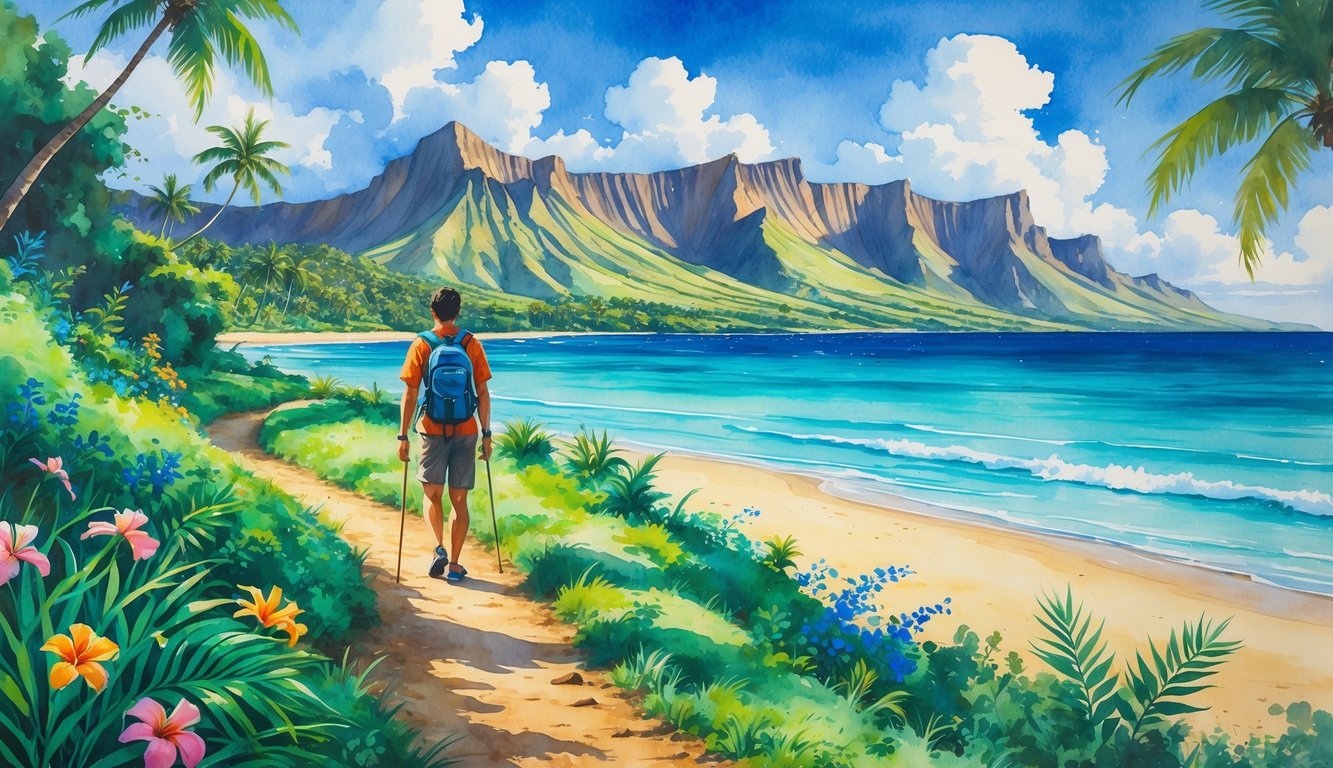
Exploring Hawaii on my own lets me set my own pace and fully enjoy the natural beauty. The islands are full of adventures that help me reconnect with nature and stay active.
Hiking Iconic Trails and Scenic Landscapes
Hiking in Hawaii is unforgettable. Some of the most breathtaking trails include the Kalalau Trail on the Na Pali Coast, which has lush valleys and dramatic cliffs.
Waimea Canyon, called the “Grand Canyon of the Pacific,” offers colorful vistas and many routes, from easy walks to tough hikes.
My top spots to hike:
- Na Pali Coast (Kalalau Trail)
- Waimea Canyon Trails
- Mauna Kea Summit
When I go solo, I start early to avoid crowds. I check trail conditions and let someone know my plans.
I keep a small daypack with water, snacks, a rain jacket, and sunscreen. The views on these hikes—like standing above clouds on Mauna Kea—are some of my favorite memories in Hawaii.
Snorkeling, Surfing, and Water Activities
Hawaii’s warm waters let me explore coral reefs and spot sea turtles up close. Snorkeling at beaches such as Hanauma Bay or the North Shore is peaceful and easy for solo travelers.
Guided tours help beginners feel safe if trying a new spot. I also love taking a surfing lesson.
Many beach towns like Waikiki and the North Shore offer group lessons where I meet other travelers. If I want something laid-back, paddleboarding or kayaking gives me a way to enjoy clear water at my own pace.
Must-try water experiences:
- Snorkeling at Hanauma Bay and North Shore
- Surfing lessons in Waikiki
- Kayaking in Kailua or along calm coastal areas
Joining local water activity tours helps me learn new skills and connect with people who share my interests. For more tips, this guide on solo wellness escapes has useful advice.
Wildlife Watching and Eco-Tours
Hawaii offers unique wildlife and eco-tours perfect for solo trips.
I often join small boat tours to see dolphins and humpback whales, especially in winter.
Some tours focus on sea turtles or rare birds that I might not spot on my own.
Guides teach me about native plants, animals, and Hawaiian conservation.
I explore rainforests, volcanic landscapes, and protected marine reserves.
On the Big Island, I enjoy night snorkeling with manta rays in a group.
Favorite wildlife tours:
- Whale watching from Maui or the North Shore
- Turtle spotting at Laniakea Beach
- Birdwatching hikes in native forests
- Manta ray night snorkeling off Kona
Guides keep me safe and help me appreciate the island’s fragile ecosystems.
For more solo trip ideas, I find inspiration in this solo adventure bucket list.
Cultural Immersion and Historic Sites
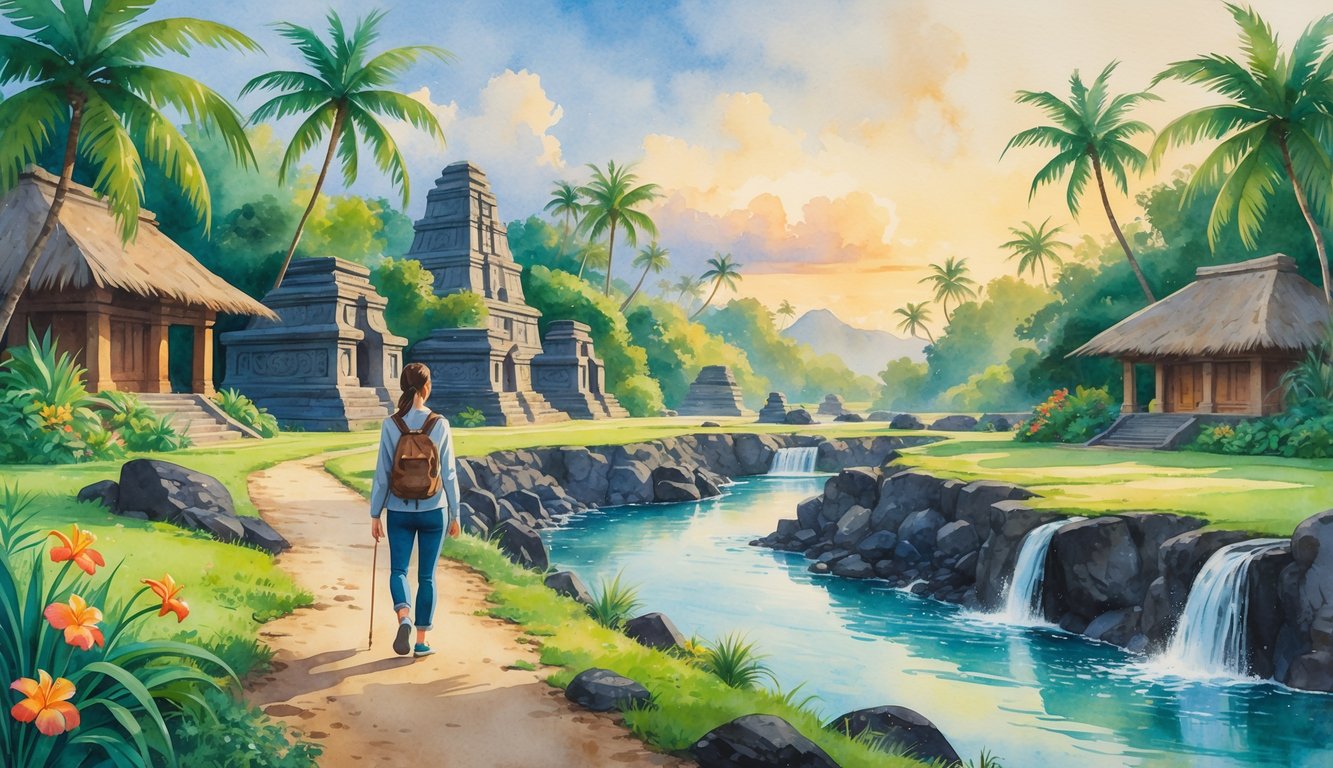
When I travel solo for wellness, I make time to learn about the history and culture of my destination.
In Hawaii, connecting with local stories and traditions helps me feel grounded and welcome.
Experiencing Hawaiian History
Hawaiian history is rich with stories of ancient kings, explorers, and ocean voyages.
I visit places like Pearl Harbor to understand the past.
When I walk through the Pearl Harbor Historic Sites, such as the USS Arizona Memorial, I learn about World War II and its impact on Hawaii.
Historic walking tours show me old homes, royal palaces, and museums that explain ancient Hawaiian society.
Museums like the Bishop Museum in Honolulu display royal artifacts, traditional canoes, and historic photos.
Learning about these details gives me a fuller sense of how Hawaiians lived and how their culture survived.
Exploring Sacred Sites and Monuments
Many solo travelers want a meaningful connection with the land.
In Hawaii, I visit sacred places called “heiau” (temples) and important monuments.
I like to start at sites like the Waimea Valley on Oahu, which blends botanical gardens with ancient altars and spiritual ceremonies.
Guided tours give me insight into how Hawaiians respected the land and spirits.
Some areas ask me to be quiet or wear respectful clothing.
At places like Puʻuhonua o Hōnaunau National Historical Park, I walk in the footsteps of ancient Hawaiians seeking refuge and forgiveness.
Reading plaques or joining a local guide helps me understand the stories behind carved stones or statues.
Taking time to pause and reflect at each location helps me connect with Hawaii’s deep spiritual traditions.
Festivals and Local Workshops
Attending local festivals and workshops lets me join in real Hawaiian culture.
Events such as the Merrie Monarch Festival on the Big Island celebrate traditional hula, music, and crafts.
At smaller community events, I watch lei making, coconut weaving, or ukulele performances.
I also look for hands-on workshops that welcome solo travelers.
For example, Waimea Valley offers cultural demonstrations and lei-making classes led by Hawaiian cultural specialists.
Participating in these activities lets me experience aloha firsthand and pick up new wellness practices from local people.
Many resorts and community centers post calendars of cultural classes like lei crafting, hula dancing, and ukulele lessons.
Joining these workshops helps me connect with other travelers and locals.
Solo Dining and Unique Hawaiian Flavors

Food in Hawaii is full of fresh flavors, vibrant colors, and a mix of cultural influences.
When I travel solo, trying new dishes helps me feel connected to the islands.
Sampling Local Dishes: Poke and Plate Lunch
One of my favorite things to eat in Hawaii is poke.
This traditional dish uses fresh, raw fish like ahi tuna, marinated with soy sauce, onions, sesame oil, and seaweed.
I pick up poke from small local markets or specialty poke shops and enjoy it at the beach.
The best poke bowls are customizable, so I can choose my toppings and sides.
Plate lunches are another classic Hawaiian meal.
They usually come with two scoops of rice, macaroni salad, and a main dish like kalua pork, teriyaki chicken, or fried fish.
Many casual spots and food trucks serve these filling, affordable meals daily.
Eating a plate lunch gives me a taste of local home-style cooking and plenty of energy for outdoor adventures.
For more tips on where to eat solo in places like Waikiki, I find some great solo dining spots in Waikiki that serve everything from casual to fine dining.
Trying Lilikoi Shave Ice and Sweet Treats
After a salty meal or a warm beach walk, I cool off with shave ice.
Lilikoi—also called passion fruit—is a tropical flavor that’s tart and sweet.
When poured over finely shaved ice, lilikoi syrup makes a refreshing treat.
Shave ice stands let me pick a combo of flavors, and I can add extras like mochi balls or condensed milk.
Other sweet Hawaiian treats I look for include haupia (coconut pudding) and malasadas (Portuguese-style donuts).
Visiting local bakeries is a fun way to find these snacks.
Some bakeries sell ube rolls, guava cake, or butter mochi, all of which taste best when they’re fresh.
I keep an eye out for farm stands or markets that offer unique, locally-made jams and candies featuring tropical fruits.
These are a great way to sample real island flavor.
Enjoying Kona Coffee and Macadamia Nuts
I love starting my mornings in Hawaii with a cup of Kona coffee.
Grown on Hawaii Island, this coffee is famous for its smooth, rich flavor and low acidity.
Many coffee shops serve freshly brewed Kona coffee, and some plantations offer tours and tastings.
Sampling different roasts lets me discover my favorite style.
Macadamia nuts are another staple snack here.
I see them everywhere in Hawaii, both roasted and covered in chocolate.
Sometimes I pick up a small bag at a shop or farmers market.
They’re crunchy, buttery, and a great energy boost between activities.
Some cafes make homemade macadamia nut butter or pastries filled with these nuts.
Trying them fresh is a must for any wellness trip.
Seeking Out Hawaiian Chocolates
Hawaii is the only place in the United States where cacao grows, so I always taste local chocolate.
I visit chocolate shops or farms to learn how cacao is harvested and turned into bars or truffles.
The chocolates here often feature island flavors, like passion fruit or coconut blended with dark or milk chocolate.
Some stores carry specialty bars infused with Kona coffee or sprinkled with roasted macadamia nuts.
I try a mix of samples to find my favorites.
Even airports and farmers markets sell packaged Hawaiian chocolates, which make great gifts or sweet snacks for later.
Packing Essentials for a Solo Wellness Journey
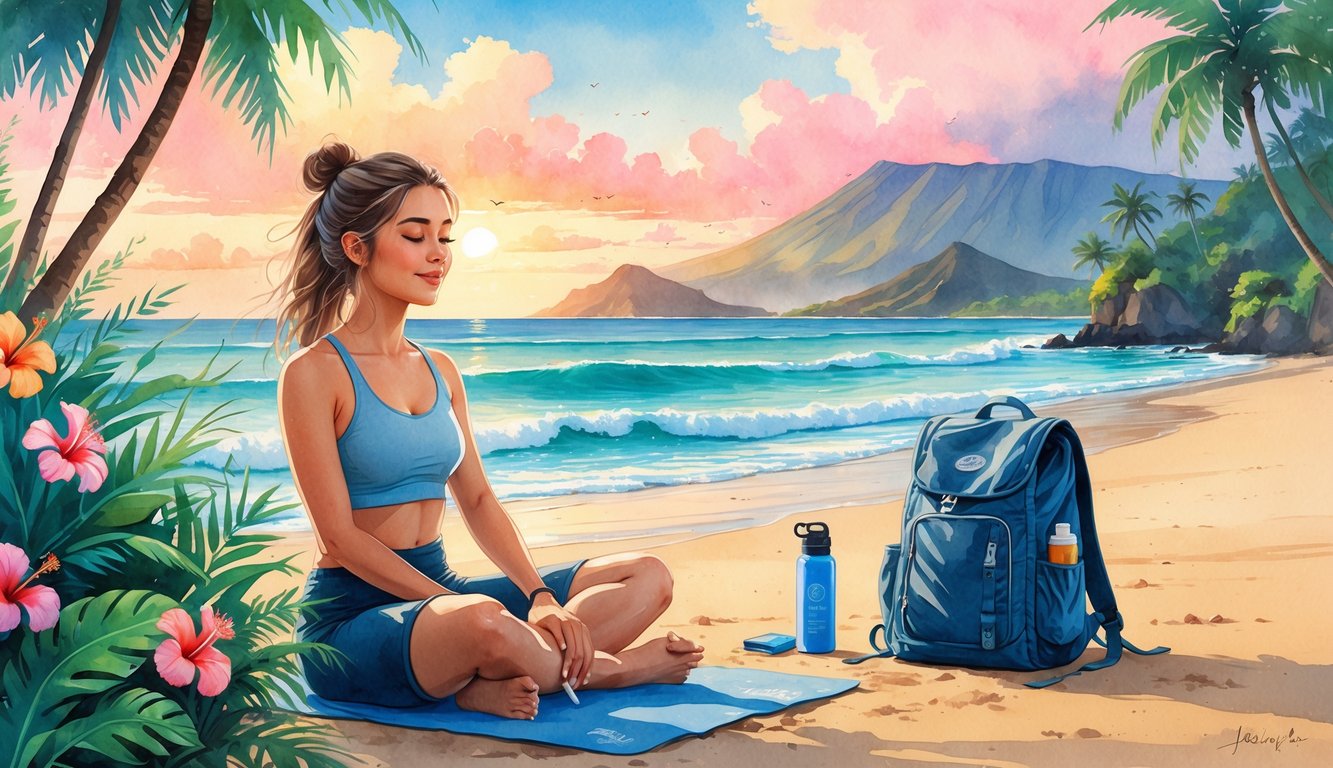
Packing for my solo wellness trip to Hawaii means choosing items that are light, practical, and safe.
I focus on comfort, self-care, and being ready for any adventure or moment of relaxation.
Choosing Lightweight Clothing
When I pack for Hawaii, I make sure every piece of clothing is light and breathable.
I choose fabrics like cotton, linen, or quick-dry blends to stay cool in the tropical heat.
I usually pack two to three pairs of shorts, a couple of t-shirts or tank tops, and a light dress or two for both yoga and a night out.
For sunrise hikes or cool evenings, I bring a thin jacket or breathable sweater.
I always include a sun hat and sunglasses for protection.
Sandals and one pair of sturdy walking shoes are enough for both beaches and trails.
I keep my color palette simple, so everything mixes and matches.
My swimwear doubles as workout gear, which means I carry less and stay prepared for spontaneous dips in the ocean or pool.
Keeping it light helps me move easily and keeps my bag manageable.
Wellness and Safety Gear
Wellness is a big part of my trip, so I pack a small kit with travel-sized sunscreen, bug spray, and after-sun lotion.
I bring a reusable water bottle to stay hydrated, as well as a yoga mat that folds or rolls up small.
My favorite guided meditation or fitness app is downloaded and ready on my phone.
Safety is just as important.
I carry a basic first aid kit with bandages, pain relievers, and any routine medications.
A portable charger keeps my phone powered up, and I have a list of local emergency contacts saved.
I never forget my personal ID, travel insurance info, and copies of important documents, stored both on my phone and in a secure spot in my bag.
For added peace of mind, I use a small lock or anti-theft pouch for valuables—a tip I found in many solo packing lists for travelers.
Safety and Wellness Tips for Solo Travel in Hawaii
When I travel alone in Hawaii, I focus on staying safe and taking care of myself.
I also make the most of the solo travel experience by connecting with locals and trying new things.
Staying Connected and Informed
I always keep my phone fully charged and carry a portable charger.
Cell service can be spotty on some beaches or hiking trails, so I download offline maps ahead of time.
I share my trip details and location with a trusted family member or friend.
I check weather updates and local news each morning, especially if I plan to hike or swim in the ocean.
Rip currents and quick-changing weather are real risks.
I look up which areas are safe, and I pay attention to lifeguard warnings and posted signs on beaches.
If I join a group for a class or tour, I research the company ahead of time.
For extra peace of mind, I join online communities like solo female traveler groups.
People share advice and might meet up for coffee or an adventure.
For more tips on staying alert and connected, I check advice from local guides, such as those at Island Hopper Guides.
Embracing the Solo Travel Experience
I remind myself that solo travel lets me set my own pace and design my trip around wellness.
I practice self-care, like doing yoga at sunrise or taking a quiet walk on the beach.
Making new friends feels easier than I thought, especially in hostels or group fitness classes.
I plan to explore popular sites, but I also leave time for spontaneous moments.
When I’m alone, I listen to my intuition and avoid places or situations that seem unsafe.
I check reviews for safe locations and keep my drinks and valuables with me.
Hawaii’s friendly locals often help me or share tips when I ask.
For ideas on solo-friendly spots and activities, I read advice from locals who travel alone.


